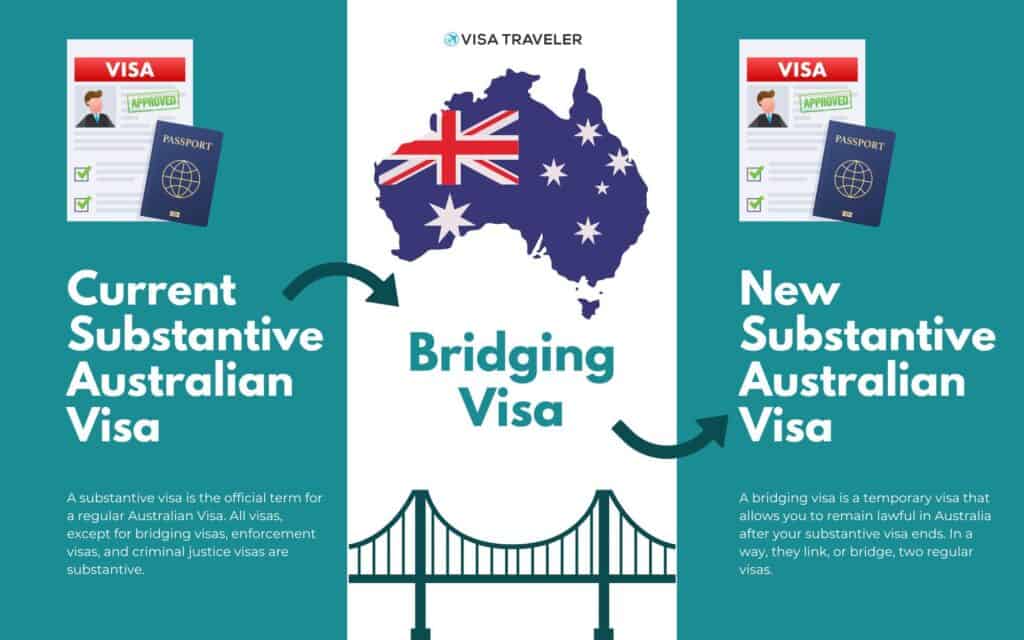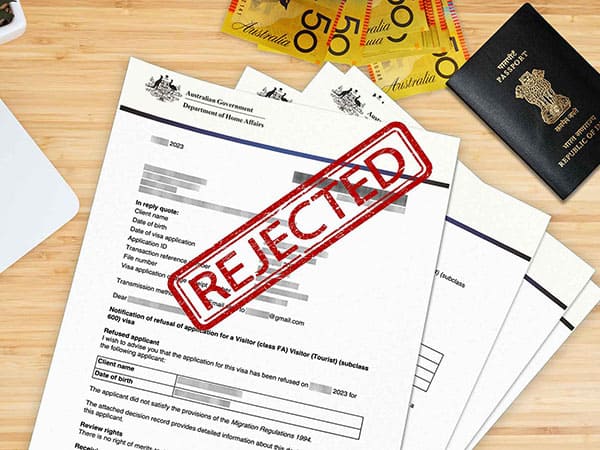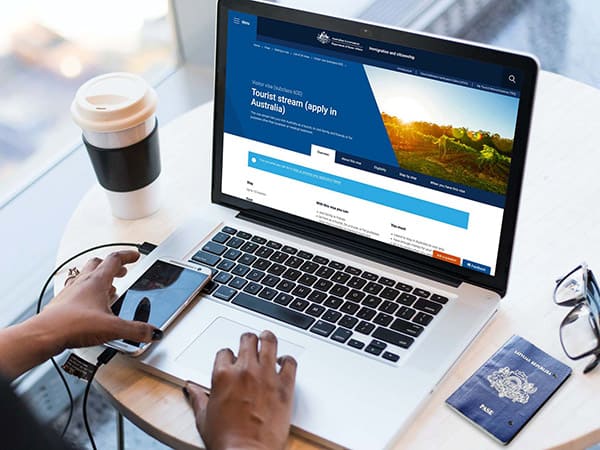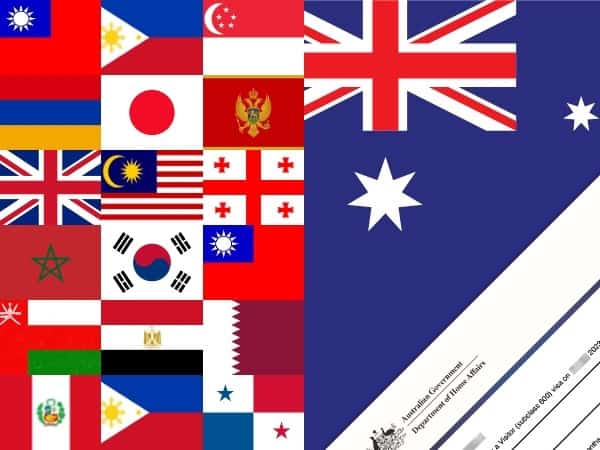
Australian Bridging Visas are temporary visas that allow you to stay in Australia legally while waiting for a visa decision or making plans to leave.
You can only be issued a bridging visa if you’re inside Australia. Tourists need a bridging visa to extend their stay in Australia. In most such cases, a bridging visa will be issued automatically as part of a new substantive visa application.
There are 7 types of bridging visas. They are BVA, BVB, BVC, BVD, BVE, BVF, and BVR. Some of these are rare and only for fringe cases. Tourists may be interested in BVA, BVC, BVD, and BVE.
Table of Contents
What is a Bridging Visa?
A bridging visa is a temporary visa that allows you to remain lawful in Australia after your substantive visa ends. In a way, they link, or bridge, two regular visas.
An issued bridging visa comes into effect when your current substantive visa ceases and until you obtain a new substantive visa or depart Australia (except for BVB). You must be in Australia when applying for a bridging visa. All bridging visas are free.
Some people live in Australia for years on a bridging visa while waiting for a decision on their substantive visa application or judicial review. For ordinary tourists, a bridging visa will be issued if you decide to extend your stay in Australia by applying for a new visa.
What is a Substantive Visa?
A substantive visa is the official term for a regular Australian visa. All visas, except for bridging visas, enforcement visas, and criminal justice visas are substantive.
What kinds of Bridging Visas are there?
There are 7 kinds of bridging visas with slight differences in use, rules, and entitlements.
| Type | Summary of Use |
|---|---|
| Bridging Visa A (BVA) | You get BVA if you apply for a new visa while still holding a valid visa. |
| Bridging Visa B (BVB) | Apply for BVB if you need to leave and return to Australia. |
| Bridging Visa C (BVC) | You get BVC if you apply for a new visa but don’t hold a valid visa. |
| Bridging Visa D (BVD) | You get BVD if you applied for a new visa but some technical or logistical problem occurred. |
| Bridging Visa E (BVE) | Apply for BVE if you’re in Australia unlawfully and planning to leave. |
| Bridging Visa F (BVF) | BVF is only for victims of human trafficking, slavery, or deceptive recruiting. |
| Bridging Visa R (BVR) | BVR is only for those released from Detention Centers after the 2023 NZYQ ruling who cannot be reasonably deported. |
Bridging Visa A (BVA)
Bridging Visa A is what most tourists would get when they apply for a new visa to extend their stay in Australia.
It is applied for automatically when you make a valid application for a substantive visa if your current one hasn’t expired yet. In most circumstances, it is also granted automatically.
It comes into effect the moment your substantive visa ceases. It remains valid until:
- You leave Australia
- Your new substantive visa has been approved
- You get a Bridging Visa B
If the substantial visa you apply for is refused, Bridging Visa A remains valid for 35 days after. You must leave Australia within these 35 days.
Bridging Visa B (BVB)
Bridging Visa B allows you to travel out of Australia and return within a specified period. This is the only bridging visa that allows you to return to Australia if you leave.
You have to apply for bridging visa B, it’s not granted automatically like BVA. You can apply while holding either a substantive visa or a BVA.
You will have to convince Home Affairs that you need to travel out of Australia. This also means that it’s highly unlikely a BVB will be granted to a genuine tourist.
Bridging Visa C (BVC)
You will automatically apply for Bridging Visa C if you apply for a substantive visa while NOT holding a valid substantive visa. Most BVCs are also automatically granted.
In all other regards, BVC is similar to BVA.
As a tourist. you may need a BVC if you overstayed your visitor visa, and then applied for another substantive visa. I don’t recommend you overstay any visa in the hopes of staying longer on a bridging visa.
Bridging Visa D (BVD)
You may apply for a Bridging Visa D if you tried to lodge an application for a new substantive visa but some problem occurred and your current visa will expire within 3 business days.
Bridging Visa D is valid for 5 business days to allow you to successfully apply for the substantive visa. You will be regarded as a “Prospective Applicant”.
You must’ve genuinely tried to apply when you encountered an issue. Examples of such problems are:
- You didn’t pay the correct visa fee
- You filled out an incorrect form
- There is no available officer to interview you
As a tourist, you shouldn’t wait until the last few days to apply for a new visa. If you don’t leave this until the last 3 days of your current visa, you won’t need a Bridging Visa D at all.
Bridging Visa E (BVE)
You may apply for Bridging Visa E if you’re currently in Australia without a valid visa (i.e. you’re unlawful) and want to make arrangements to leave the country.
The BVE is a last resort for most people after they’ve exhausted all other visa options. It usually comes with strict conditions, reporting requirements, and is seen as an act of clemency instead of getting placed in detention and deported forcefully
As a tourist, if your visitor visa expires and you haven’t made an attempt to apply for a new substantive visa, it’s in your best interest to apply for a Bridging Visa E as soon as possible and make plans to leave Australia.
Bridging Visa F (BVF)
Bridging Visa F is issued only to subjects of human trafficking, modern slavery, or other serious international crimes. As such, it is of no interest to tourists.
Bridging Visa R (BVR)
Bridging Visa R is issued to people who are in immigration detention but because of practical considerations cannot be deported. Australia’s High Court ruled indefinite immigration detention as unlawful in late 2023, thus creating the need for this bridging visa. BVR is of no interest to tourists.
Work Rights
As a genuine tourist, you don’t have the right to work in Australia to begin with. You will not have any work rights under any bridging visa either.
Work rights may be given in exceptional circumstances if you show that you’re in financial hardship.
Frequently Asked Questions
Can I use a bridging visa to stay in Australia longer?
The primary purpose of a bridging visa is so that you remain lawful while waiting on a decision for a new substantive visa or while planning to leave Australia. Yes, it allows you to stay longer, but you shouldn’t rely on it to keep staying in Australia as a tourist.
What to do if my Visitor Visa is expiring soon?
Either leave Australia or apply for a new substantive visa in which case you will most likely be granted Bridging Visa A.
What to do if I have overstayed my Visitor Visa?
You can either apply for a new substantive visa and be granted a Bridging Visa C or apply for Bridging Visa E and make plans to leave Australia as soon as possible.
How long can I stay on a bridging visa if my substantive visa application is refused?
For BVA, BVB, and BVC, you can stay up to 35 days after your new substantive visa application is refused.
On a BVE, you must make plans to leave Australia promptly.

 9 Reasons for Australia Visa Denial (And How to Avoid Them)
9 Reasons for Australia Visa Denial (And How to Avoid Them) Australia Visa Extension: How to Extend Your Stay in Australia
Australia Visa Extension: How to Extend Your Stay in Australia 18 VISA-FREE Countries You Can Visit with Australian Visa or PR [2024 Edition]
18 VISA-FREE Countries You Can Visit with Australian Visa or PR [2024 Edition]